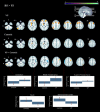Atypical neuronal activation during a spatial working memory task in 13-year-old very preterm children
- PMID: 28940977
- PMCID: PMC6867106
- DOI: 10.1002/hbm.23820
Atypical neuronal activation during a spatial working memory task in 13-year-old very preterm children
Abstract
Children born very preterm (VP; <32 weeks' gestational age) are at risk for unfavorable outcomes in several cognitive domains, including spatial working memory (WM). The underlying neural basis of these cognitive impairments is poorly understood. We investigated differences in neuronal activation during spatial WM using a backward span (BS) task relative to a control (C) task in 45 VP children and 19 term-born controls aged 13 years. VP children showed significantly more activation in the bilateral superior frontal gyrus and significantly less activation in the left parahippocampal gyrus compared with controls. We further explored the distinct contributions of maintenance and manipulation processes of WM using forward span (FS)>C and BS > FS, respectively. There were no significant group differences in neuronal activation for FS > C. However, BS > FS revealed that VP children had significantly greater activation in the left middle frontal gyrus, in the left superior parietal gyrus and right cerebellar tonsil, and significantly less activation in the right precentral and postcentral gyrus and left insula compared with controls. Taken together these results suggest that VP children at 13 years of age show an atypical neuronal activation during spatial WM, specifically related to manipulation of spatial information in WM. It is unclear whether these findings reflect delayed maturation and/or recruitment of alternative neuronal networks as a result of neuroplasticity. Hum Brain Mapp 38:6172-6184, 2017. © 2017 Wiley Periodicals, Inc.
Keywords: behavior and behavior mechanisms; child development; memory; mental competency; mental processes; neurobehavioral manifestations; premature birth; short-term.
© 2017 Wiley Periodicals, Inc.
Figures




Similar articles
-
Working memory in preterm-born adults: load-dependent compensatory activity of the posterior default mode network.Hum Brain Mapp. 2015 Mar;36(3):1121-37. doi: 10.1002/hbm.22691. Epub 2014 Nov 21. Hum Brain Mapp. 2015. PMID: 25413496 Free PMC article.
-
The neurodevelopmental differences of increasing verbal working memory demand in children and adults.Dev Cogn Neurosci. 2016 Feb;17:19-27. doi: 10.1016/j.dcn.2015.10.008. Epub 2015 Nov 5. Dev Cogn Neurosci. 2016. PMID: 26615571 Free PMC article.
-
Spatial Working Memory Impairment in Patients with Non-neuropsychiatric Systemic Lupus Erythematosus: A Blood-oxygen-level Dependent Functional Magnetic Resonance Imaging Study.J Rheumatol. 2017 Feb;44(2):201-208. doi: 10.3899/jrheum.160290. Epub 2017 Jan 15. J Rheumatol. 2017. PMID: 28089970
-
Dysfunctional neural network of spatial working memory contributes to developmental dyscalculia.Neuropsychologia. 2009 Nov;47(13):2859-65. doi: 10.1016/j.neuropsychologia.2009.06.009. Epub 2009 Jun 21. Neuropsychologia. 2009. PMID: 19540861
-
Nurturing the preterm infant brain: leveraging neuroplasticity to improve neurobehavioral outcomes.Pediatr Res. 2019 Jan;85(2):166-175. doi: 10.1038/s41390-018-0203-9. Epub 2018 Oct 16. Pediatr Res. 2019. PMID: 30531968 Review.
Cited by
-
Prenatal cannabis exposure predicts attention problems, without changes on fMRI in adolescents.Neurotoxicol Teratol. 2022 May-Jun;91:107089. doi: 10.1016/j.ntt.2022.107089. Epub 2022 Mar 18. Neurotoxicol Teratol. 2022. PMID: 35314358 Free PMC article.
-
Language and sensory characteristics are reflected in voice-evoked responses in low birth weight children.Pediatr Res. 2025 Jan;97(1):120-127. doi: 10.1038/s41390-024-03270-9. Epub 2024 Jun 21. Pediatr Res. 2025. PMID: 38902452 Free PMC article.
-
Spectral slowing is associated with working memory performance in children born very preterm.Sci Rep. 2019 Oct 31;9(1):15757. doi: 10.1038/s41598-019-52219-0. Sci Rep. 2019. PMID: 31673006 Free PMC article. Clinical Trial.
-
Neurocognitive function and associations with mental health in adults born preterm with very low birthweight or small for gestational age at term.Front Psychol. 2023 Jan 18;13:1078232. doi: 10.3389/fpsyg.2022.1078232. eCollection 2022. Front Psychol. 2023. PMID: 36743594 Free PMC article.
References
-
- Anderson PJ, Doyle LW (2004): Executive functioning in school‐aged children who were born very preterm or with extremely low birth weight in the 1990s. Pediatrics 114:50–57. - PubMed
-
- Baddeley AD, Hitch G (1974): Working memory In: Gordon HB, editors. Psychology of Learning and Motivation, Vol. 8 Academic Press; pp. 47–89.
Publication types
MeSH terms
LinkOut - more resources
Full Text Sources
Other Literature Sources
Medical

